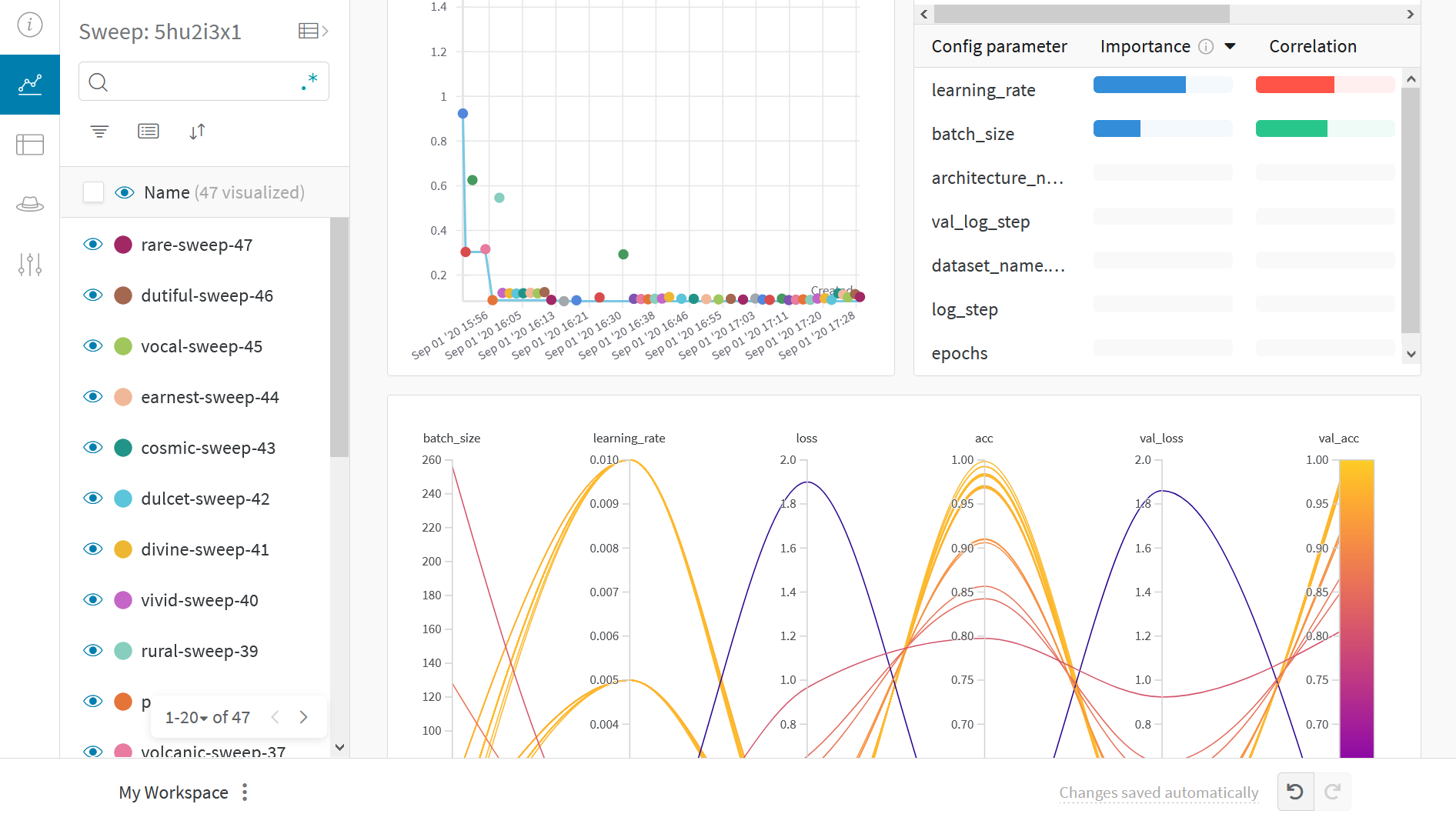TensorFlow Sweeps
5 minute read

Use Weights & Biases Sweeps to automate hyperparameter optimization and explore the space of possible models, complete with interactive dashboards like this:

Why Should I Use Sweeps?
- Quick setup: With just a few lines of code, you can run W&B sweeps.
- Transparent: The project cites all algorithms used, and the code is open source.
- Powerful: Sweeps are completely customizable and configurable. You can launch a sweep across dozens of machines, and it’s just as easy as starting a sweep on your laptop.
Check out the official documentation
What this notebook covers
- Simple steps to get started with W&B Sweep with custom training loop in TensorFlow.
- Finding the best hyperparameters for an image classification task.
Note: Sections starting with Step are all you need to perform hyperparameter sweep in existing code. The rest of the code is there to set up a simple example.
Install, Import, and Log in
Install W&B
%%capture
!pip install wandb
Import W&B and Login
import tqdm
import tensorflow as tf
from tensorflow import keras
from tensorflow.keras.datasets import cifar10
import os
import numpy as np
import pandas as pd
import matplotlib.pyplot as plt
import wandb
from wandb.integration.keras import WandbMetricsLogger
wandb.login()
Side note: If this is your first time using W&B or you are not logged in, the link that appears after running
wandb.login()will take you to sign-up/login page. Signing up is as easy as a few clicks.
Prepare Dataset
# Prepare the training dataset
(x_train, y_train), (x_test, y_test) = keras.datasets.mnist.load_data()
x_train = x_train / 255.0
x_test = x_test / 255.0
x_train = np.reshape(x_train, (-1, 784))
x_test = np.reshape(x_test, (-1, 784))
Build a Simple Classifier MLP
def Model():
inputs = keras.Input(shape=(784,), name="digits")
x1 = keras.layers.Dense(64, activation="relu")(inputs)
x2 = keras.layers.Dense(64, activation="relu")(x1)
outputs = keras.layers.Dense(10, name="predictions")(x2)
return keras.Model(inputs=inputs, outputs=outputs)
def train_step(x, y, model, optimizer, loss_fn, train_acc_metric):
with tf.GradientTape() as tape:
logits = model(x, training=True)
loss_value = loss_fn(y, logits)
grads = tape.gradient(loss_value, model.trainable_weights)
optimizer.apply_gradients(zip(grads, model.trainable_weights))
train_acc_metric.update_state(y, logits)
return loss_value
def test_step(x, y, model, loss_fn, val_acc_metric):
val_logits = model(x, training=False)
loss_value = loss_fn(y, val_logits)
val_acc_metric.update_state(y, val_logits)
return loss_value
Write a Training Loop
def train(
train_dataset,
val_dataset,
model,
optimizer,
loss_fn,
train_acc_metric,
val_acc_metric,
epochs=10,
log_step=200,
val_log_step=50,
):
for epoch in range(epochs):
print("\nStart of epoch %d" % (epoch,))
train_loss = []
val_loss = []
# Iterate over the batches of the dataset
for step, (x_batch_train, y_batch_train) in tqdm.tqdm(
enumerate(train_dataset), total=len(train_dataset)
):
loss_value = train_step(
x_batch_train,
y_batch_train,
model,
optimizer,
loss_fn,
train_acc_metric,
)
train_loss.append(float(loss_value))
# Run a validation loop at the end of each epoch
for step, (x_batch_val, y_batch_val) in enumerate(val_dataset):
val_loss_value = test_step(
x_batch_val, y_batch_val, model, loss_fn, val_acc_metric
)
val_loss.append(float(val_loss_value))
# Display metrics at the end of each epoch
train_acc = train_acc_metric.result()
print("Training acc over epoch: %.4f" % (float(train_acc),))
val_acc = val_acc_metric.result()
print("Validation acc: %.4f" % (float(val_acc),))
# Reset metrics at the end of each epoch
train_acc_metric.reset_states()
val_acc_metric.reset_states()
# 3️⃣ log metrics using wandb.log
wandb.log(
{
"epochs": epoch,
"loss": np.mean(train_loss),
"acc": float(train_acc),
"val_loss": np.mean(val_loss),
"val_acc": float(val_acc),
}
)
Configure the Sweep
This is where you will:
- Define the hyperparameters you’re sweeping over
- Provide your hyperparameter optimization method. We have
random,gridandbayesmethods. - Provide an objective and a
metricif usingbayes, for example tominimizetheval_loss. - Use
hyperbandfor early termination of poorly performing runs.
Check out more on Sweep Configs
sweep_config = {
"method": "random",
"metric": {"name": "val_loss", "goal": "minimize"},
"early_terminate": {"type": "hyperband", "min_iter": 5},
"parameters": {
"batch_size": {"values": [32, 64, 128, 256]},
"learning_rate": {"values": [0.01, 0.005, 0.001, 0.0005, 0.0001]},
},
}
Wrap the Training Loop
You’ll need a function, like sweep_train below,
that uses wandb.config to set the hyperparameters
before train gets called.
def sweep_train(config_defaults=None):
# Set default values
config_defaults = {"batch_size": 64, "learning_rate": 0.01}
# Initialize wandb with a sample project name
wandb.init(config=config_defaults) # this gets over-written in the Sweep
# Specify the other hyperparameters to the configuration, if any
wandb.config.epochs = 2
wandb.config.log_step = 20
wandb.config.val_log_step = 50
wandb.config.architecture_name = "MLP"
wandb.config.dataset_name = "MNIST"
# build input pipeline using tf.data
train_dataset = tf.data.Dataset.from_tensor_slices((x_train, y_train))
train_dataset = (
train_dataset.shuffle(buffer_size=1024)
.batch(wandb.config.batch_size)
.prefetch(buffer_size=tf.data.AUTOTUNE)
)
val_dataset = tf.data.Dataset.from_tensor_slices((x_test, y_test))
val_dataset = val_dataset.batch(wandb.config.batch_size).prefetch(
buffer_size=tf.data.AUTOTUNE
)
# initialize model
model = Model()
# Instantiate an optimizer to train the model.
optimizer = keras.optimizers.SGD(learning_rate=wandb.config.learning_rate)
# Instantiate a loss function.
loss_fn = keras.losses.SparseCategoricalCrossentropy(from_logits=True)
# Prepare the metrics.
train_acc_metric = keras.metrics.SparseCategoricalAccuracy()
val_acc_metric = keras.metrics.SparseCategoricalAccuracy()
train(
train_dataset,
val_dataset,
model,
optimizer,
loss_fn,
train_acc_metric,
val_acc_metric,
epochs=wandb.config.epochs,
log_step=wandb.config.log_step,
val_log_step=wandb.config.val_log_step,
)
Initialize Sweep and Run Agent
sweep_id = wandb.sweep(sweep_config, project="sweeps-tensorflow")
You can limit the number of total runs with the count parameter, we will limit a 10 to make the script run fast, feel free to increase the number of runs and see what happens.
wandb.agent(sweep_id, function=sweep_train, count=10)
Visualize Results
Click on the Sweep URL link above to see your live results.
Example Gallery
See examples of projects tracked and visualized with W&B in the Gallery →
Best Practices
- Projects: Log multiple runs to a project to compare them.
wandb.init(project="project-name") - Groups: For multiple processes or cross validation folds, log each process as a runs and group them together.
wandb.init(group='experiment-1') - Tags: Add tags to track your current baseline or production model.
- Notes: Type notes in the table to track the changes between runs.
- Reports: Take quick notes on progress to share with colleagues and make dashboards and snapshots of your ML projects.
Advanced Setup
- Environment variables: Set API keys in environment variables so you can run training on a managed cluster.
- Offline mode
- On-prem: Install W&B in a private cloud or air-gapped servers in your own infrastructure. Everyone from academics to enterprise teams use local installations.
Feedback
Was this page helpful?
Glad to hear it! Please tell us how we can improve.
Sorry to hear that. Please tell us how we can improve.